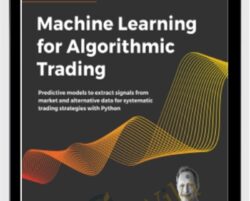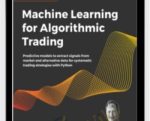About this bookThe explosive growth of digital data has boosted the demand for expertise in trading strategies that use machine learning (ML). This thoroughly revised and expanded second edition enables you to build and evaluate sophisticated supervised, unsupervised, and reinforcement learning models.This edition introduces end-to-end machine learning for the trading workflow, from the idea and feature engineering to model optimization, strategy design, and backtesting. It illustrates this workflow using examples that range from linear models and tree-based ensembles to deep-learning techniques from the cutting edge of the research frontier.This revised version shows how to work with market, fundamental, and alternative data, such as tick data, minute and daily bars, SEC filings, earnings call transcripts, financial news, or satellite images to generate tradeable signals. It illustrates how to engineer financial features or alpha factors that enable a machine learning model to predict returns from price data for US and international stocks and ETFs. It also demonstrates how to assess the signal content of new features using Alphalens and SHAP values and includes a new appendix with over one hundred alpha factor examples.By the end of the book, you will be proficient in translating machine learning model predictions into a trading strategy that operates at daily or intraday horizons, and in evaluating its performance.Machine Learning for Trading – From Idea to ExecutionAlgorithmic trading relies on computer programs that execute algorithms to automate some or all elements of a trading strategy. Algorithms are a sequence of steps or rules designed to achieve a goal. They can take many forms and facilitate optimization throughout the investment process, from idea generation to asset allocation, trade execution, and risk management.Machine learning (ML) involves algorithms that learn rules or patterns from data to achieve a goal such as minimizing a prediction error. The examples in this book will illustrate how ML algorithms can extract information from data to support or automate key investment activities. These activities include observing the market and analyzing data to form expectations about the future and decide on placing buy or sell orders, as well as managing the resulting portfolio to produce attractive returns relative to the risk.Ultimately, the goal of active investment management is to generate alpha, defined as portfolio returns in excess of the benchmark used for evaluation. The fundamental law of active management postulates that the key to generating alpha is having accurate return forecasts combined with the ability to act on these forecasts (Grinold 1989; Grinold and Kahn 2000).This law defines the information ratio (IR) to express the value of active management as the ratio of the return difference between the portfolio and a benchmark to the volatility of those returns. It further approximates the IR as the product of the following:The information coefficient (IC), which measures the quality of forecasts as their rank correlation with outcomesThe square root of the breadth of a strategy expressed as the number of independent bets on these forecastsThe competition of sophisticated investors in financial markets implies that making precise predictions to generate alpha requires superior information, either through access to better data, a superior ability to process it, or both.This is where ML comes in: applications of ML for trading (ML4T) typically aim to make more efficient use of a rapidly diversifying range of data to produce both better and more actionable forecasts, thus improving the quality of investment decisions and results.Historically, algorithmic trading used to be more narrowly defined as the automation of trade execution to minimize the costs offered by the sell-side. This book takes a more comprehensive perspective since the use of algorithms in general and ML in particular has come to impact a broader range of activities, from generating ideas and extracting signals from data to asset allocation, position-sizing, and testing and evaluating strategies.This chapter looks at industry trends that have led to the emergence of ML as a source of competitive advantage in the investment industry. We will also look at where ML fits into the investment process to enable algorithmic trading strategies. More specifically, we will be covering the following topics:Key trends behind the rise of ML in the investment industryThe design and execution of a trading strategy that leverages MLPopular use cases for ML in tradingGet Machine Learning for Algorithmic Trading (Second Edition) – Stefan Jansen, Only Price $27The rise of ML in the investment industryThe investment industry has evolved dramatically over the last several decades and continues to do so amid increased competition, technological advances, and a challenging economic environment. This section reviews key trends that have shaped the overall investment environment and the context for algorithmic trading and the use of ML more specifically.The trends that have propelled algorithmic trading and ML to their current prominence include:Changes in the market microstructure, such as the spread of electronic trading and the integration of markets across asset classes and geographiesThe development of investment strategies framed in terms of risk-factor exposure, as opposed to asset classesThe revolutions in computing power, data generation and management, and statistical methods, including breakthroughs in deep learningThe outperformance of the pioneers in algorithmic trading relative to human, discretionary investorsIn addition, the financial crises of 2001 and 2008 have affected how investors approach diversification and risk management. One outcome is the rise in low-cost passive investment vehicles in the form of exchange-traded funds (ETFs).Amid low yields and low volatility following the 2008 crisis, which triggered large-scale asset purchases by leading central banks, cost-conscious investors shifted over $3.5 trillion from actively managed mutual funds into passively managed ETFs.Competitive pressure is also reflected in lower hedge fund fees, which dropped from the traditional 2 percent annual management fee and 20 percent take of profits to an average of 1.48 percent and 17.4 percent, respectively, in 2017.From electronic to high-frequency tradingElectronic trading has advanced dramatically in terms of capabilities, volume, coverage of asset classes, and geographies since networks started routing prices to computer terminals in the 1960s. Equity markets have been at the forefront of this trend worldwide. See Harris (2003) and Strumeyer (2017) for comprehensive coverage of relevant changes in financial markets; we will return to this topic when we cover how to work with market and fundamental data in the next chapter.The 1997 order-handling rules by the SEC introduced competition to exchanges through electronic communication networks (ECNs). ECNs are automated alternative trading systems (ATS) that match buy-and-sell orders at specified prices, primarily for equities and currencies, and are registered as broker-dealers. It allows significant brokerages and individual traders in different geographic locations to trade directly without intermediaries, both on exchanges and after hours.Dark pools are another type of private ATS that allows institutional investors to trade large orders without publicly revealing their information, contrary to how exchanges managed their order books prior to competition from ECNs. Dark pools do not publish pre-trade bids and offers, and trade prices only become public some time after execution. They have grown substantially since the mid-2000s to account for 40 percent of equities traded in the US due to concerns about adverse price movements of large orders and order front-running by high-frequency traders. They are often housed within large banks and are subject to SEC regulation.With the rise of electronic trading, algorithms for cost-effective execution developed rapidly and adoption spread quickly from the sell-side to the buy-side and across asset classes. Automated trading emerged around 2000 as a sell-side tool aimed at cost-effective execution that broke down orders into smaller, sequenced chunks to limit their market impact. These tools spread to the buy side and became increasingly sophisticated by taking into account, for example, transaction costs and liquidity, as well as short-term price and volume forecasts.Direct market access (DMA) gives a trader greater control over execution by allowing them to send orders directly to the exchange using the infrastructure and market participant identification of a broker who is a member of an exchange. Sponsored access removes pre-trade risk controls by the brokers and forms the basis for high-frequency trading (HFT).HFT refers to automated trades in financial instruments that are executed with extremely low latency in the microsecond range and where participants hold positions for very short periods. The goal is to detect and exploit inefficiencies in the market microstructure, the institutional infrastructure of trading venues.HFT has grown substantially over the past 10 years and is estimated to make up roughly 55 percent of trading volume in US equity markets and about 40 percent in European equity markets. HFT has also grown in futures markets to roughly 80 percent of foreign-exchange futures volumes and two-thirds of both interest rate and Treasury 10-year futures volumes (Miller 2016).HFT strategies aim to earn small profits per trade using passive or aggressive strategies. Passive strategies include arbitrage trading to profit from very small price differentials for the same asset, or its derivatives, traded on different venues. Aggressive strategies include order anticipation or momentum ignition. Order anticipation, also known as liquidity detection, involves algorithms that submit small exploratory orders to detect hidden liquidity from large institutional investors and trade ahead of a large order to benefit from subsequent price movements. Momentum ignition implies an algorithm executing and canceling a series of orders to spoof other HFT algorithms into buying (or selling) more aggressively and benefit from the resulting price changes.Regulators have expressed concern over the potential link between certain aggressive HFT strategies and increased market fragility and volatility, such as that experienced during the May 2010 Flash Crash, the October 2014 Treasury market volatility, and the sudden crash by over 1,000 points of the Dow Jones Industrial Average on August 24, 2015. At the same time, market liquidity has increased with trading volumes due to the presence of HFT, which has lowered overall transaction costs.The combination of reduced trading volumes amid lower volatility and rising costs of technology and access to both data and trading venues has led to financial pressure. Aggregate HFT revenues from US stocks were estimated to have dropped beneath $1 billion in 2017 for the first time since 2008, down from $7.9 billion in 2009. This trend has led to industry consolidation, with various acquisitions by, for example, the largest listed proprietary trading firm, Virtu Financial, and shared infrastructure investments, such as the new Go West ultra-low latency route between Chicago and Tokyo. Simultaneously, start-ups such as Alpha Trading Labs are making HFT trading infrastructure and data available to democratize HFT by crowdsourcing algorithms in return for a share of the profits.Factor investing and smart beta fundsThe return provided by an asset is a function of the uncertainty or risk associated with the investment. An equity investment implies, for example, assuming a company’s business risk, and a bond investment entails default risk. To the extent that specific risk characteristics predict returns, identifying and forecasting the behavior of these risk factors becomes a primary focus when designing an investment strategy. It yields valuable trading signals and is the key to superior active-management results. The industry’s understanding of risk factors has evolved very substantially over time and has impacted how ML is used for trading. Chapter 4, Financial Feature Engineering – How to Research Alpha Factors, and Chapter 5, Portfolio Optimization and Performance Evaluation, will dive deeper into the practical applications of the concepts outlined here; see Ang (2014) for comprehensive coverage.Modern portfolio theory (MPT) introduced the distinction between idiosyncratic and systematic sources of risk for a given asset. Idiosyncratic risk can be eliminated through diversification, but systematic risk cannot. In the early 1960s, the capital asset pricing model (CAPM) identified a single factor driving all asset returns: the return on the market portfolio in excess of T-bills. The market portfolio consisted of all tradable securities, weighted by their market value. The systematic exposure of an asset to the market is measured by beta, which is the correlation between the returns of the asset and the market portfolio.The recognition that the risk of an asset does not depend on the asset in isolation, but rather how it moves relative to other assets and the market as a whole, was a major conceptual breakthrough. In other words, assets earn a risk premium based on their exposure to underlying, common risks experienced by all assets, not due to their specific, idiosyncratic characteristics.Subsequently, academic research and industry experience have raised numerous critical questions regarding the CAPM prediction that an asset’s risk premium depends only on its exposure to a single factor measured by the asset’s beta. Instead, numerous additional risk factors have since been discovered. A factor is a quantifiable signal, attribute, or any variable that has historically correlated with future stock returns and is expected to remain correlated in the future.These risk factors were labeled anomalies since they contradicted the efficient market hypothesis (EMH). The EMH maintains that market equilibrium would always price securities according to the CAPM so that no other factors should have predictive power (Malkiel 2003). The economic theory behind factors can be either rational, where factor risk premiums compensate for low returns during bad times, or behavioral, where agents fail to arbitrage away excess returns.Well-known anomalies include the value, size, and momentum effects that help predict returns while controlling for the CAPM market factor. The size effect rests on small firms systematically outperforming large firms (Banz 1981; Reinganum 1981). The value effect (Basu et. al. 1981) states that firms with low valuation metrics outperform their counterparts with the opposite characteristics. It suggests that firms with low price multiples, such as the price-to-earnings or the price-to-book ratios, perform better than their more expensive peers (as suggested by the inventors of value investing, Benjamin Graham and David Dodd, and popularized by Warren Buffet).The momentum effect, discovered in the late 1980s by, among others, Clifford Asness, the founding partner of AQR, states that stocks with good momentum, in terms of recent 6-12 month returns, have higher returns going forward than poor momentum stocks with similar market risk. Researchers also found that value and momentum factors explain returns for stocks outside the US, as well as for other asset classes, such as bonds, currencies, and commodities, and additional risk factors (Jegadeesh and Titman 1993; Asness, Moskowitz, and Pedersen 2013).In fixed income, the value strategy is called riding the yield curve and is a form of the duration premium. In commodities, it is called the roll return, with a positive return for an upward-sloping futures curve and a negative return otherwise. In foreign exchange, the value strategy is called carry.There is also an illiquidity premium. Securities that are more illiquid trade at low prices and have high average excess returns, relative to their more liquid counterparts. Bonds with a higher default risk tend to have higher returns on average, reflecting a credit risk premium. Since investors are willing to pay for insurance against high volatility when returns tend to crash, sellers of volatility protection in options markets tend to earn high returns.Multifactor models define risks in broader and more diverse terms than just the market portfolio. In 1976, Stephen Ross proposed the arbitrage pricing theory, which asserted that investors are compensated for multiple systematic sources of risk that cannot be diversified away (Roll and Ross 1984). The three most important macro factors are growth, inflation, and volatility, in addition to productivity, demographic, and political risk. In 1993, Eugene Fama and Kenneth French combined the equity risk factors’ size and value with a market factor into a single three-factor model that better explained cross-sectional stock returns. They later added a model that also included bond risk factors to simultaneously explain returns for both asset classes (Fama and French 1993; 2015).A particularly attractive aspect of risk factors is their low or negative correlation. Value and momentum risk factors, for instance, are negatively correlated, reducing the risk and increasing risk-adjusted returns above and beyond the benefit implied by the risk factors. Furthermore, using leverage and long-short strategies, factor strategies can be combined into market-neutral approaches. The combination of long positions in securities exposed to positive risks with underweight or short positions in the securities exposed to negative risks allows for the collection of dynamic risk premiums.As a result, the factors that explained returns above and beyond the CAPM were incorporated into investment styles that tilt portfolios in favor of one or more factors, and assets began to migrate into factor-based portfolios. The 2008 financial crisis underlined how asset-class labels could be highly misleading and create a false sense of diversification when investors do not look at the underlying factor risks, as asset classes came crashing down together.Over the past several decades, quantitative factor investing has evolved from a simple approach based on two or three styles to multifactor smart or exotic beta products. Smart beta funds have crossed $1 trillion AUM in 2017, testifying to the popularity of the hybrid investment strategy that combines active and passive management. Smart beta funds take a passive strategy but modify it according to one or more factors, such as cheaper stocks or screening them according to dividend payouts, to generate better returns. This growth has coincided with increasing criticism of the high fees charged by traditional active managers as well as heightened scrutiny of their performance.The ongoing discovery and successful forecasting of risk factors that, either individually or in combination with other risk factors, significantly impact future asset returns across asset classes is a key driver of the surge in ML in the investment industry and will be a key theme throughout this book.Algorithmic pioneers outperform humansThe track record and growth of assets under management (AUM) of firms that spearheaded algorithmic trading has played a key role in generating investor interest and subsequent industry efforts to replicate their success. Systematic funds differ from HFT in that trades may be held significantly longer while seeking to exploit arbitrage opportunities as opposed to advantages from sheer speed.Systematic strategies that mostly or exclusively rely on algorithmic decision-making were most famously introduced by mathematician James Simons, who founded Renaissance Technologies in 1982 and built it into the premier quant firm. Its secretive Medallion Fund, which is closed to outsiders, has earned an estimated annualized return of 35 percent since 1982.D. E. Shaw, Citadel, and Two Sigma, three of the most prominent quantitative hedge funds that use systematic strategies based on algorithms, rose to the all-time top-20 performers for the first time in 2017, in terms of total dollars earned for investors, after fees, and since inception.D. E. Shaw, founded in 1988 and with $50 billion in AUM in 2019, joined the list at number 3. Citadel, started in 1990 by Kenneth Griffin, manages $32 billion, and ranked 5. Two Sigma, started only in 2001 by D. E. Shaw alumni John Overdeck and David Siegel, has grown from $8 billion in AUM in 2011 to $60 billion in 2019. Bridgewater, started by Ray Dalio in 1975, had over $160 billion in AUM in 2019 and continues to lead due to its Pure Alpha fund, which also incorporates systematic strategies.Similarly, on the Institutional Investors 2018 Hedge Fund 100 list, the four largest firms, and five of the top six firms, rely largely or completely on computers and trading algorithms to make investment decisions—and all of them have been growing their assets in an otherwise challenging environment. Several quantitatively focused firms climbed the ranks and, in some cases, grew their assets by double-digit percentages. Number 2-ranked Applied Quantitative Research (AQR) grew its hedge fund assets by 48 percent in 2017 and by 29 percent in 2018 to nearly $90 billion.Get Machine Learning for Algorithmic Trading (Second Edition) – Stefan Jansen, Only Price $27ML-driven funds attract $1 trillion in AUMThe familiar three revolutions in computing power, data availability, and statistical methods have made the adoption of systematic, data-driven strategies not only more compelling and cost-effective but a key source of competitive advantage.As a result, algorithmic approaches are not only finding wider application in the hedge-fund industry that pioneered these strategies but across a broader range of asset managers and even passively managed vehicles such as ETFs. In particular, predictive analytics using ML and algorithmic automation play an increasingly prominent role in all steps of the investment process across asset classes, from idea generation and research to strategy formulation and portfolio construction, trade execution, and risk management.Estimates of industry size vary because there is no objective definition of a quantitative or algorithmic fund. Many traditional hedge funds or even mutual funds and ETFs are introducing computer-driven strategies or integrating them into a discretionary environment in a human-plus-machine approach.According to the Economist, in 2016, systematic funds became the largest driver of institutional trading in the US stock market (ignoring HFT, which mainly acts as a middleman). In 2019, they accounted for over 35 percent of institutional volume, up from just 18 percent in 2010; just 10% of trading is still due to traditional equity funds. Measured by the Russell 3000 index, the value of US stocks is around $31 trillion. The three types of computer-managed funds—index funds, ETFs, and quant funds—run around 35 percent, whereas human managers at traditional hedge funds and other mutual funds manage just 24 percent.The market research firm Preqin estimates that almost 1,500 hedge funds make a majority of their trades with help from computer models. Quantitative hedge funds are now responsible for 27 percent of all US stock trades by investors, up from 14 percent in 2013. But many use data scientists—or quants—who, in turn, use machines to build large statistical models.In recent years, however, funds have moved toward true ML, where artificially intelligent systems can analyze large amounts of data at speed and improve themselves through such analyses. Recent examples include Rebellion Research, Sentient, and Aidyia, which rely on evolutionary algorithms and deep learning to devise fully automatic artificial intelligence (AI)-driven investment platforms.From the core hedge fund industry, the adoption of algorithmic strategies has spread to mutual funds and even passively managed EFTs in the form of smart beta funds, and to discretionary funds in the form of quantamental approaches.The emergence of quantamental fundsTwo distinct approaches have evolved in active investment management: systematic (or quant) and discretionary investing. Systematic approaches rely on algorithms for a repeatable and data-driven approach to identify investment opportunities across many securities. In contrast, a discretionary approach involves an in-depth analysis of the fundamentals of a smaller number of securities. These two approaches are becoming more similar as fundamental managers take more data science-driven approaches.Even fundamental traders now arm themselves with quantitative techniques, accounting for $55 billion of systematic assets, according to Barclays. Agnostic to specific companies, quantitative funds trade based on patterns and dynamics across a wide swath of securities. Such quants accounted for about 17 percent of total hedge fund assets, as data compiled by Barclays in 2018 showed.Point72, with $14 billion in assets, has been shifting about half of its portfolio managers to a human-plus-machine approach. Point72 is also investing tens of millions of dollars into a group that analyzes large amounts of alternative data and passes the results on to traders.Investments in strategic capabilitiesThree trends have boosted the use of data in algorithmic trading strategies and may further shift the investment industry from discretionary to quantitative styles:The exponential increase in the availability of digital dataThe increase in computing power and data storage capacity at a lower costThe advances in statistical methods for analyzing complex datasetsRising investments in related capabilities—technology, data, and, most importantly, skilled humans—highlight how significant algorithmic trading using ML has become for competitive advantage, especially in light of the rising popularity of passive, indexed investment vehicles, such as ETFs, since the 2008 financial crisis.Morgan Stanley noted that only 23 percent of its quant clients say they are not considering using or not already using ML, down from 44 percent in 2016. Guggenheim Partners built what it calls a supercomputing cluster for $1 million at the Lawrence Berkeley National Laboratory in California to help crunch numbers for Guggenheim’s quant investment funds. Electricity for computers costs another $1 million per year.AQR is a quantitative investment group that relies on academic research to identify and systematically trade factors that have, over time, proven to beat the broader market. The firm used to eschew the purely computer-powered strategies of quant peers such as Renaissance Technologies or DE Shaw. More recently, however, AQR has begun to seek profitable patterns in markets using ML to parse through novel datasets, such as satellite pictures of shadows cast by oil wells and tankers.The leading firm BlackRock, with over $5 trillion in AUM, also bets on algorithms to beat discretionary fund managers by heavily investing in SAE, a systematic trading firm it acquired during the financial crisis. Franklin Templeton bought Random Forest Capital, a debt-focused, data-led investment company, for an undisclosed amount, hoping that its technology can support the wider asset manager.ML and alternative dataHedge funds have long looked for alpha through informational advantage and the ability to uncover new uncorrelated signals. Historically, this included things such as proprietary surveys of shoppers, or of voters ahead of elections or referendums.Occasionally, the use of company insiders, doctors, and expert networks to expand knowledge of industry trends or companies crosses legal lines: a series of prosecutions of traders, portfolio managers, and analysts for using insider information after 2010 has shaken the industry.In contrast, the informational advantage from exploiting conventional and alternative data sources using ML is not related to expert and industry networks or access to corporate management, but rather the ability to collect large quantities of very diverse data sources and analyze them in real time.Conventional data includes economic statistics, trading data, or corporate reports. Alternative data is much broader and includes sources such as satellite images, credit card sales, sentiment analysis, mobile geolocation data, and website scraping, as well as the conversion of data generated in the ordinary course of business into valuable intelligence. It includes, in principle, any data source containing (potential) trading signals.For instance, data from an insurance company on the sales of new car insurance policies captures not only the volumes of new car sales but can be broken down into brands or geographies. Many vendors scrape websites for valuable data, ranging from app downloads and user reviews to airline and hotel bookings. Social media sites can also be scraped for hints on consumer views and trends.Typically, the datasets are large and require storage, access, and analysis using scalable data solutions for parallel processing, such as Hadoop and Spark. There are more than 1 billion websites with more than 10 trillion individual web pages, with 500 exabytes (or 500 billion gigabytes) of data, according to Deutsche Bank. And more than 100 million websites are added to the internet every year.Real-time insights into a company’s prospects, long before their results are released, can be gleaned from a decline in job listings on its website, the internal rating of its chief executive by employees on the recruitment site Glassdoor, or a dip in the average price of clothes on its website. Such information can be combined with satellite images of car parks and geolocation data from mobile phones that indicate how many people are visiting stores. On the other hand, strategic moves can be learned from a jump in job postings for specific functional areas or in certain geographies.Among the most valuable sources is data that directly reveals consumer expenditures, with credit card information as a primary source. This data offers only a partial view of sales trends, but it can offer vital insights when combined with other data. Point72, for instance, at some point analyzed 80 million credit card transactions every day. We will explore the various sources, their use cases, and how to evaluate them in detail in Chapter 3, Alternative Data for Finance – Categories and Use Cases.Investment groups have more than doubled their spending on alternative sets and data scientists in the past two years, as the asset management industry has tried to reinvigorate its fading fortunes. In December 2018, there were 375 alternative data providers listed on alternativedata.org (sponsored by provider Yipit).Asset managers spent a total of $373 million on datasets and hiring new employees to parse them in 2017, up 60 percent from 2016, and will probably spend a total of $616 million this year, according to a survey of investors by alternativedata.org. It forecast that overall expenditures will climb to over $1 billion by 2020. Some estimates are even higher: Optimus, a consultancy, estimates that investors are spending about $5 billion per year on alternative data, and expects the industry to grow 30 percent per year over the coming years.As competition for valuable data sources intensifies, exclusivity arrangements are a key feature of data-source contracts, to maintain an informational advantage. At the same time, privacy concerns are mounting, and regulators have begun to start looking at the currently largely unregulated data-provider industry.Crowdsourcing trading algorithmsMore recently, several algorithmic trading firms have begun to offer investment platforms that provide access to data and a programming environment to crowdsource risk factors that become part of an investment strategy or entire trading algorithms. Key examples include WorldQuant, Quantopian, and, most recently, Alpha Trading Labs (launched in 2018).WorldQuant was spun out of Millennium Management (AUM: $41 billion) in 2007, for whom it manages around $5 billion. It employs hundreds of scientists and many more part-time workers around the world in its alpha factory, which or
 Penny Likes Formula – Reed Floren
₹2,158.00
Penny Likes Formula – Reed Floren
₹2,158.00
 Pimp Your Lingo: Advanced Conversation Skills For Men – Stephan Erdman
₹5,478.00
Pimp Your Lingo: Advanced Conversation Skills For Men – Stephan Erdman
₹5,478.00
Machine Learning for Algorithmic Trading (Second Edition) – Stefan Jansen
₹3,818.00





